

Over the past 30 years, semirural Lake County has developed into a metropolitan "collar" county. Formerly punctuated by two larger cities (Waukegan and North Chicago) and a sprinkling of smaller towns linked by open space and agricultural land, the county has become a less defined network of residential, commercial, and industrial centers. With that transformation, Lake County has had to cope with emerging urban problems, such as traffic congestion, stress on public infrastructure and services, differing rates of growth of land values and property assessments, and rising housing costs.
During this time of enormous change and growth, Lake County (with the cities of Waukegan and North Chicago) has developed an action plan using Community Development Block Grant (CDBG), HOME, Emergency Shelter Grant (ESG), and Continuum of Care SuperNOFA funding to meet its affordable housing, homelessness, and community development needs. These three units of local government have formed a consortium to administer the HOME Investment Partnership Program.
The Lake County Consolidated Plan was developed with considerable community input, including four general public meetings (each in different areas of the county), eight focus group forums with service providers in areas of concern such as homelessness, and surveys of provider organizations. To encourage public input, the Needs Statement and Strategic Plan were sent to all municipalities and townships, as well as to an extensive list of provider agencies and other interested parties during its 1-month comment period.
Lake County is one of the fastest growing counties in the Chicago Consolidated Metropolitan Statistical Area (CMSA), although the population of North Chicago generally has been declining. The new households are also smaller than in the past; while the population increased by 35 percent between 1970 and 1990, the number of households increased by 69 percent. This statistic has tremendous impact on the need for additional affordable housing. In 1990, 87 percent of the county's households were white, 6 percent were African-American, 5 percent were Hispanic, and 2 percent were Asian-American/Pacific Islander. The minority populations are growing at a much faster rate than the majority. The 1980s saw a 45-percent increase in Hispanic residents and a 52-percent increase in Asian-American/Pacific Islander residents. While only 5.2 percent of households in the county were below the poverty level, 64 percent of African-Americans and 52 percent of Hispanics were either very low- or low-income, compared with 24 percent of whites and 23 percent of Asian-American/Pacific Islanders.
Lake County had a 53-percent increase in the number of jobs in the 1980s, with a shift in job growth away from the northern shore of Lake Michigan to a decentralized area along the Tri-State expressway corridor and in the southern portion of the county. Most of these new jobs are not close to residential areas affordable for low- and moderate-income households.
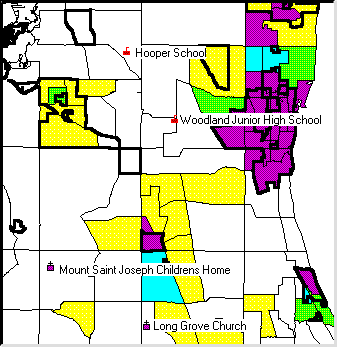

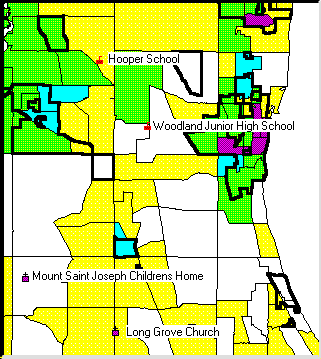
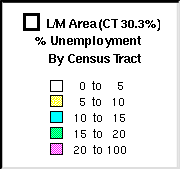
Between 1970 and 1990, Lake County gained 40,048 housing units (a 36-percent increase). The majority of these were single-family detached houses in the central and southern portions of the county, where new employment opportunities exist. Unfortunately, much of this housing is neither affordable nor appropriate to low- and moderate-income or smaller households. Also, from 1980 to 1986, the number of nonelderly, lower income housing units in Lake County fell by over 1,600.
A Housing Task Force has estimated that there will be a deficit of approximately 29,000 affordable housing units in Lake County by the year 2000. Different areas of the county have different emphases. North Chicago, for instance, expects an additional 9,000 military and civilian jobs to be created with the expansion of the Great Lakes Naval Training Center. It expects a corresponding increase in demand for affordable housing. The city of Waukegan, on the other hand, has a high percentage of renters and wants to increase numbers of first-time homeowners and emphasize rehabilitation needs of owner-occupied homes.
Different segments of the population have different affordable housing needs. The number of very low-income renter and owner households was much higher among African-American households than for any other racial group. However, Hispanics were more likely than any other racial/ethnic group to experience housing problems. The Lake County Consortium, which will administer the HOME program, has established a priority to use available housing and community development funds for low- and very low-income residents for the purposes of first-time homebuying and homeowner rehabilitation.
In addition, 28 percent of all renter households experience rental cost burdens of more than 30 percent of their incomes. There is a need for rental assistance, new affordable rental construction, and rehabilitation of vacant or substandard units.
The average-valued mortgaged home in the county was $189,016 in 1990, while the average home sale price between January and August 1991 was $136,468. The disparity in changes in median home values demonstrates that the separation between higher and lower cost housing has widened. The Lake County Housing Task Force stated in 1991 that only .54 adequate affordable units are available for each low- and moderate-income household. Most of the housing for purchase in Lake County is unaffordable for households whose income is less than $46,400. The housing that is attainable is generally in older communities along the northern lakeshore and is both farther from employment opportunities and at greater risk of deterioration due to age.
A number of trends in Lake County characterize the housing market:
It is estimated that there are currently 62 homeless families including 136 children per month in the area. Most are headed by single women and more than 50 percent are African-American. In addition, there are approximately 54 single men and 19 single women among the homeless each month. Currently, there is no permanent emergency shelter facility in Lake County, although Connection/PADS (Public Action to Deliver Shelter) offers emergency shelter for up to 70 persons at churches throughout the county from October 1 through April 30. Catholic Charities also provides motel vouchers on an emergency basis to homeless families.
Lake County must determine if a permanent facility is needed and whether needs are being met during the summer months. Lake County's continuum-of-care resources and emergency shelter providers should increase their coordination with one another. In addition, the supply of transitional and permanent housing with support services is currently inadequate to meet need.
The Lake County Housing Authority operates public and assisted housing programs within Lake County, except in the cities of North Chicago and Waukegan, which have their own housing authorities. As of July 1994, the Lake County Housing Authority had an inventory of 276 family units and 334 elderly units. The majority of the elderly units were built in the 1980s, with none older than the 1960s. The only family complex (125 units) was built in 1962 and the scattered-site housing (151 units) was built between 1923 and 1991. Ten additional scattered-site family units are under construction. The Lake County Housing Authority has funds approved to construct 25 new elderly and 5 new family units. At any given time, over 90 percent of all public housing units meet Housing Quality Standards.
The majority of public and assisted housing is under the administration of the Waukegan Housing Authority (WHA). WHA controls 423 public housing units located on 5 separate sites as well as 25 scattered-site units. WHA has 324 Section 8 certificates, 67 Section 8 vouchers, and 135 Section 8 certificates and vouchers from other parts of the State. The waiting list for Section 8 certificates currently numbers 832 and is closed.
North Chicago's housing program consists of 543 project-based Section 8 vouchers, 185 project-based moderate rehabilitation units, 150 project-based public housing units, and 83 tenant-based Section 8 vouchers.
Lake County identified a number of specific zoning restrictions that make it harder to build affordable housing. For example, 18 of 52 municipalities in Lake County do not allow multifamily housing in their zoning ordinance (12 currently do not have public sewer service adequate for multifamily housing). Twenty-two of 50 municipalities specifically prohibit the use of accessory dwelling units and 23 municipalities have minimum lot sizes over 7,500 square feet. Building codes, restrictions on alternative construction methods such as manufactured systems, subdivision regulations, and impact fees are also barriers to affordable housing.
Lake County needs to reassess its fair housing activities and needs, particularly in view of new fair housing regulations being proposed by HUD.
Illinois law requires every physician or health-care provider to screen children 6 months to 6 years for lead poisoning. As of January 1, 1993, each day-care, preschool, nursery school, kindergarten, or other child-care facility licensed or approved by the State, including Head Start programs, require proof that the child has been screened for lead poisoning prior to admission. If a child receives a high blood level test, Lake County tests the home. It is estimated that 43,342 low-income rental and owner housing units in Lake County have lead paint. Despite the precautions already in place, Lake County needs to ascertain that no children are slipping through the safety net.
Lake County experienced major floods in 1986 and 1993 that overloaded existing stormwater detention and control systems. Drainage and stormwater-related improvements are needed. Despite generally adequate sanitary sewer access and capability in the county, several areas (especially in the northwestern and western parts of the county) have been identified where increased needs are outstripping existing infrastructure. These areas need help to expand sanitary sewer facilities and provide water system improvements. The county has also placed high importance on evaluating handicapped accessibility in public facilities to comply with the Americans With Disabilities Act.
Although Lake County is experiencing positive economic growth, a key component to the county's Housing and Community Development Consolidated Plan is to invest in those residents who are less able to take part in the thriving market. Lake County needs to ensure that its extremely low-, very low-, and low-income residents can access opportunities for employment training and related services.
The Economic Development Commission's 1992 Business Retention Survey showed that 24 percent of small businesses found it difficult or very difficult to obtain fixed asset-based loans and 32 percent found it difficult or very difficult to obtain working capital loans. To fill this gap for its entrepreneurs in low- and moderate-income areas of Lake County, the Planning Department's Economic Development Section initiated a microenterprise loan program in 1994 for startup funding.
Lake County's Strategic Plan recognizes the strong relationship between affordable housing and economic development. It seeks to make available to all residents of Lake County good quality, reasonably priced housing close enough to employment centers to allow less than a half-hour commute to work. In addition, it seeks to meet the housing and support services needs of those residents who are not able to work or who have retired.
Lake County has identified 10 actions that must be taken to ensure that all residents of Lake County have access to affordable, decent, safe, and sanitary housing appropriate to their needs:
Because of its location on a flood plain, Lake County has made it a priority to improve stormwater management systems, with a particular emphasis on areas of extremely low-, very low-, and moderate-income populations. Sanitary sewer facilities and water systems are essential because of increased growth. Lake County will focus on evaluating its services for children, youth, and families; health care; mental illness; persons with disabilities; domestic violence; the elderly; emergency food; and persons with HIV/AIDS to be sure that they are meeting the needs of its changing and growing population.
To meet the needs of Lake County residents who are not benefitting from the county's economic growth, the plan suggests a combination of activities, including analyzing current employment training resources, providing $300,000 in microenterprise loans to assist small businesses, and increasing coordination of delivery of services.
A variety of public agencies will be involved in implementing and coordinating the Housing and Community Development Strategic Plan and the Annual Action Plan. These include the Lake County Community Development Commission; Lake County Affordable Housing Commission; Lake County Economic Development Commission; Lake County Department of Planning, Zoning and Environmental Quality; Housing Authority; Development Offices of the cities of Waukegan and North Chicago; and Waukegan and North Chicago Housing Authorities. To ensure smooth coordination among so many entities and within the plan itself, Lake County proposes the following mechanisms:
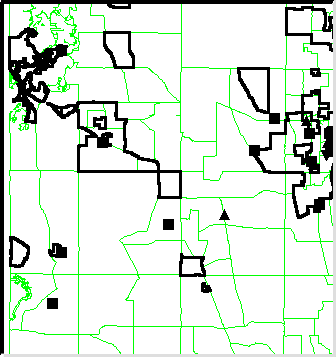
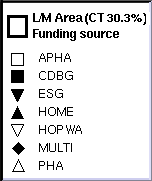
During 1995, Lake County proposes to spend $1,298,000 in HOME program allocations to fund 10 organizations in new construction, rehabilitation, CHDO operations, rental rehabilitation, and homebuyer counseling activities.
The CDBG funding allocation of $3,085,000 will be used by 41 organizations for activities, including public service, employment training, handicapped accessibility, and public facilities projects.
Lake County requests $105,000 in 1995 ESG allocations to be used by eight homeless service providers. It additionally requests $4,108,530 in continuum-of-care funds for six transitional housing programs and for tenant-based rental assistance. These projects will be located throughout the county, but will focus on areas with high concentrations of extremely low-, very low-, and low-income populations.
Highlights of the action plan include:
The Community Development Section in the County Department of Planning, Zoning and Environmental Quality will have lead responsibility for monitoring activities under the CDBG, ESG, and HOME programs, and for tracking the general progress being made under the Consolidated Plan.
The monitoring functions will include: